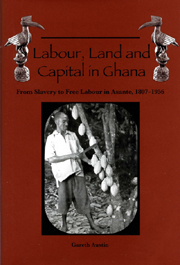Book contents
- Frontmatter
- Contents
- List of Illustrations
- List of Tables
- Preface
- Note on Names
- Maps
- Note on the Maps
- 1 Introduction
- Part I Context and Concepts
- Part II Social Relations of Production and Trade, 1807–1896: Absent and Imperfect Factor Markets
- Part III Slavery as Hobson's Choice: An Analysis of the Interaction of Markets and Coercion in Asante's Era of ‘Legitimate Commerce’, 1807–1896
- Part IV The Decline of Coercion in the Factor Markets of Colonial Asante: Cocoa and the Ending of Slavery, Pawnship and Corvée, 1896–c.1950
- Part V Social Relations of Production and Trade, 1908–1956: Towards Integrated Factor Markets?
- Part VI Freedom and Forest Rent, 1908–1956
- Abbreviations Used in the Notes
- Notes
- List of References
- Index
Part III - Slavery as Hobson's Choice: An Analysis of the Interaction of Markets and Coercion in Asante's Era of ‘Legitimate Commerce’, 1807–1896
Published online by Cambridge University Press: 12 September 2012
- Frontmatter
- Contents
- List of Illustrations
- List of Tables
- Preface
- Note on Names
- Maps
- Note on the Maps
- 1 Introduction
- Part I Context and Concepts
- Part II Social Relations of Production and Trade, 1807–1896: Absent and Imperfect Factor Markets
- Part III Slavery as Hobson's Choice: An Analysis of the Interaction of Markets and Coercion in Asante's Era of ‘Legitimate Commerce’, 1807–1896
- Part IV The Decline of Coercion in the Factor Markets of Colonial Asante: Cocoa and the Ending of Slavery, Pawnship and Corvée, 1896–c.1950
- Part V Social Relations of Production and Trade, 1908–1956: Towards Integrated Factor Markets?
- Part VI Freedom and Forest Rent, 1908–1956
- Abbreviations Used in the Notes
- Notes
- List of References
- Index
Summary
This part investigates the causes and consequences of the role of slavery and other forms of property in people in the nineteenth-century Asante economy. Chapter 8 examines the standard economic explanation of slavery against qualitative and quantitative evidence for Asante. It argues that such property claims, founded on coercion, reduced the supply price of labour and thereby made possible a much higher level of economic activity than would have been possible otherwise. Important as they were, we have seen that slavery, pawning and corvée were not the only sets of extra-economic relations to structure economic activity. The significance of the gender division of labour, and the primacy of the conjugal family unit over the otherwise socially-pervasive matrilineage, are discussed in Chapter 9. The opportunities that the pattern of property rights and markets in factors of production offered for individual careers of accumulation are explored in Chapter 10. It goes on to consider the implications for the welfare of the various parties involved, and issues of consent and resistance. In this context we ask whether, or how far, slavery and pawnship were instruments of social integration, underpinned by paternalistic ideologies, as well as means of extracting economic rent.
- Type
- Chapter
- Information
- Labour, Land and Capital in GhanaFrom Slavery to Free Labour in Asante, 1807–1956, pp. 153 - 154Publisher: Boydell & BrewerPrint publication year: 2005



